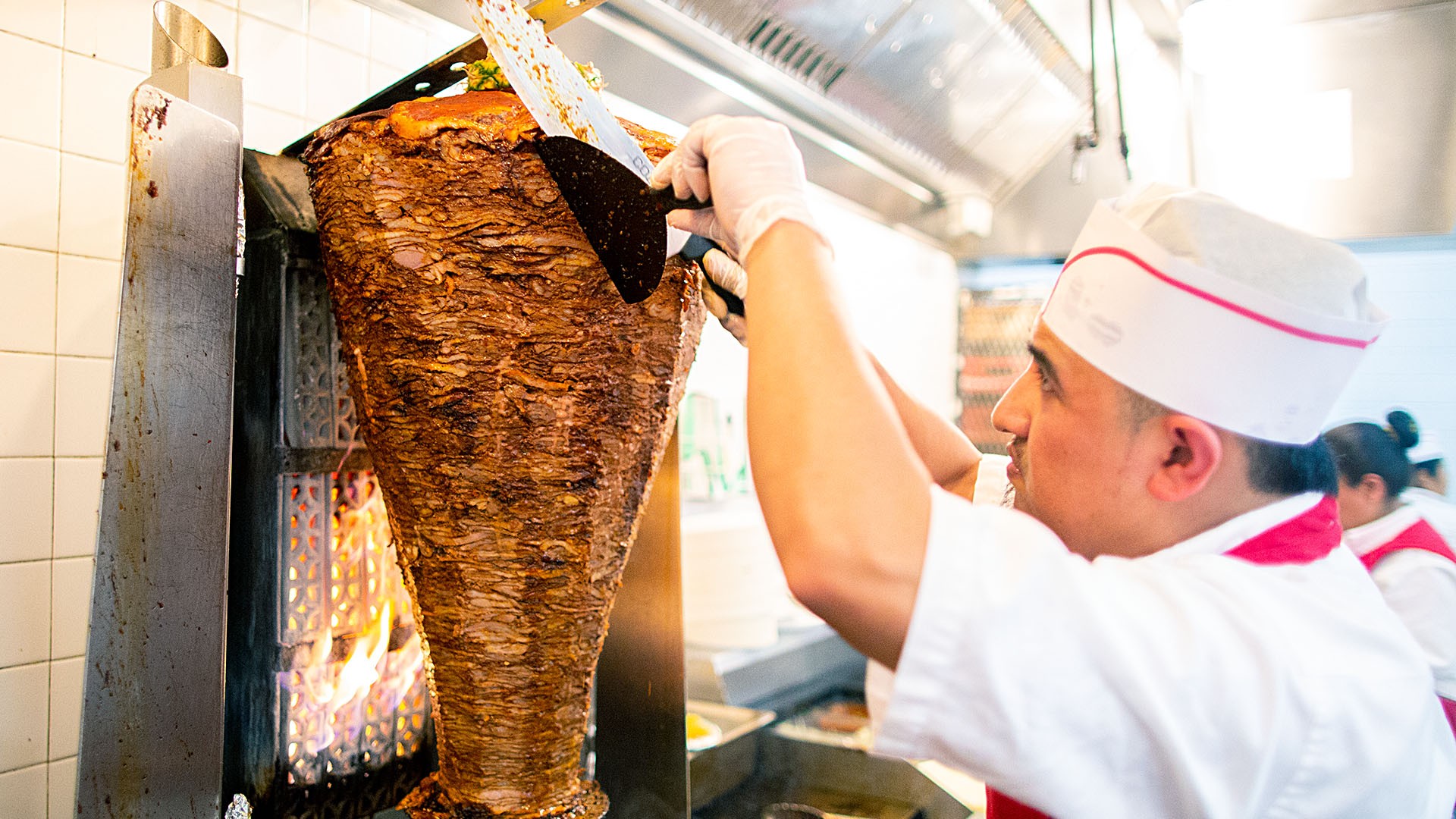Hangovers are brutal. As anyone flexing their time on Earth will tell you, the older you get, the worse they are. In my three-and-a-half decades of living like a trash goblin, there have been many mornings where I woke up unsure of my surroundings, with my mouth feeling like it was stuffed with cotton balls, and plagued by the sensation of rats clawing in my brain. On those mornings, I pull myself out of bed, drag my hunched body to the kitchen like Quasimodo, and reach a dying arm for the cupboard to pull out a can of Juanita's menudo—the piquant elixir of rebirth.
Related Post
It was my mom, in fact, who introduced me to Juanita's canned menudo. Lured to our family home in Tijuana with the promise of fresh-made menudo, I sat at the kitchen island we always eat at (the dinner table is reserved for bags of clothes that need to be returned to Marshall's), and fed myself spoonfuls of menudo. "Salio bien rico, verdad?" she asked. My mom never misses an opportunity for praise, so if you don't provide it immediately she'll ask for it. Yes, I told her, the menudo is dank as hell. Bravo, madre! You've done it again. She then gave me a sly grin and raised her brow. "Es de lata," she whispered.My mom pulled out an empty can of Juanita's from the trash and showed it to me, unveiling her secret. A hot, dark-haired woman (I assume Juanita) caught mid-cha cha blankly stared at me from the can's yellow label with a big, toothy smile. Oh, Juanita. You sly bitch. Juanita's menudo came to be back in 1950, four years after George de la Torre and his nephew, Albert Guerrero, opened a canning company in Wilmington, California. Guerrero's wife Ruth was the family's purveyor of menudo. Her tasty menudo, with its traditional, homestyle flavors, inspired them to can that good stuff and sell it in markets. The rest is canned culinary history.I was surprised. Our biases tell us if it's a can, it's probably crap. And I admit it's hard to imagine a can filled with beef tripe, hominy, and bright red broth would be edible, let alone delicious. I allowed my bias to assume the worst, that it would be disgusting, or have a rat foot in it, or be some bland whitewashed red water. I had little faith, but Juanita handed it to me with sass.Since that day, Juanita's menudo, both rojo and verde, as well as her pozole, are staples of my cupboard, my mom's cupboard, and my siblings' cupboards. My mom and sister Gaby spent $45 in postage to mail me four cans of Juanita's when I first moved to New York. (If anyone knows a market that sells it here, please let me know. I'm new here). At my other sister's wedding just a few weeks ago, Gaby came in clutch for the team, having packed eight industrial-sized cans of menudo, plus seven cans of hominy (there are freaks out there who refuse to eat the tripa, so you need extra hominy) for the next day's inevitable hangover. About 25 people lined up in the kitchen, loading paper bowls with heaping ladles of Juanita's. An hour later, they were all alive again, and back on the tequila for Day 2 of wedding festivities.I eventually do want to learn to make menudo, because I worry that the recipe that's so intrinsic to my culture, my upbringing, and my post-night-out revival might be lost with me—that one day I wouldn't be able to cure my future children's hangovers with its magical, nutrient-rich warmth and give them "ay, pero anoche!" But I know, if I fail completely, Juanita will be there to bring us all back to life.
Sign up for our newsletter to get the best of VICE delivered to your inbox daily.Follow Alex Zaragoza on Twitter. And send her menudo too please.
Advertisement
Menudo has long been a trusted cure for hangovers in Mexican culture. Its richness in vitamin C, iron, and fiber has made it the saving grace for the survivors of a night of raging. The morning after a quinceañera or wedding often includes giant cazuelas full of the bubbling caldo. Its scent of mouth-watering beef-bone-and-chile-de-árbol broth and kick of crushed red pepper is enough to wake up the half dead. But no one nursing the remnants of tequila in their bloodstream is going to do the hours of work it takes to get there.Even if I had a full afternoon completely free of responsibility and Don Julio-filled guts, it's still unlikely I'd willingly spend that amount of time cooking. Menudo is as time-consuming and tedious as it is delicious. There's cutting and cleaning the fuzzy beef tripe, preparing the broth, making the sauce that gives the broth its rich, smoky flavor, adding the hominy (which, fine, is only 30 seconds of work), cutting up onions and lemons to top the soup, and the five seconds it takes to open a pack of dried oregano. Who has the time?!The exhaustive prep time is why menudo is usually made in very large batches on special occasions. If you're going to do that much work, you make it worth your while. Growing up, when my mom would make menudo, we'd have frozen Tupperware containers full of it in the freezer for months. She'd thaw the ice block of menudo in her large metal cazuela, and it would slowly turn from solid, to a gross-looking gelatinous blob, to the evening's tasty dinner. Now in her late 60s, my mom flat-out refuses to make menudo. "Es una chinga," she says. It's a bitch. Even Mexican mamis agree!
Advertisement
Related Post

It was my mom, in fact, who introduced me to Juanita's canned menudo. Lured to our family home in Tijuana with the promise of fresh-made menudo, I sat at the kitchen island we always eat at (the dinner table is reserved for bags of clothes that need to be returned to Marshall's), and fed myself spoonfuls of menudo. "Salio bien rico, verdad?" she asked. My mom never misses an opportunity for praise, so if you don't provide it immediately she'll ask for it. Yes, I told her, the menudo is dank as hell. Bravo, madre! You've done it again. She then gave me a sly grin and raised her brow. "Es de lata," she whispered.My mom pulled out an empty can of Juanita's from the trash and showed it to me, unveiling her secret. A hot, dark-haired woman (I assume Juanita) caught mid-cha cha blankly stared at me from the can's yellow label with a big, toothy smile. Oh, Juanita. You sly bitch. Juanita's menudo came to be back in 1950, four years after George de la Torre and his nephew, Albert Guerrero, opened a canning company in Wilmington, California. Guerrero's wife Ruth was the family's purveyor of menudo. Her tasty menudo, with its traditional, homestyle flavors, inspired them to can that good stuff and sell it in markets. The rest is canned culinary history.I was surprised. Our biases tell us if it's a can, it's probably crap. And I admit it's hard to imagine a can filled with beef tripe, hominy, and bright red broth would be edible, let alone delicious. I allowed my bias to assume the worst, that it would be disgusting, or have a rat foot in it, or be some bland whitewashed red water. I had little faith, but Juanita handed it to me with sass.
Advertisement
